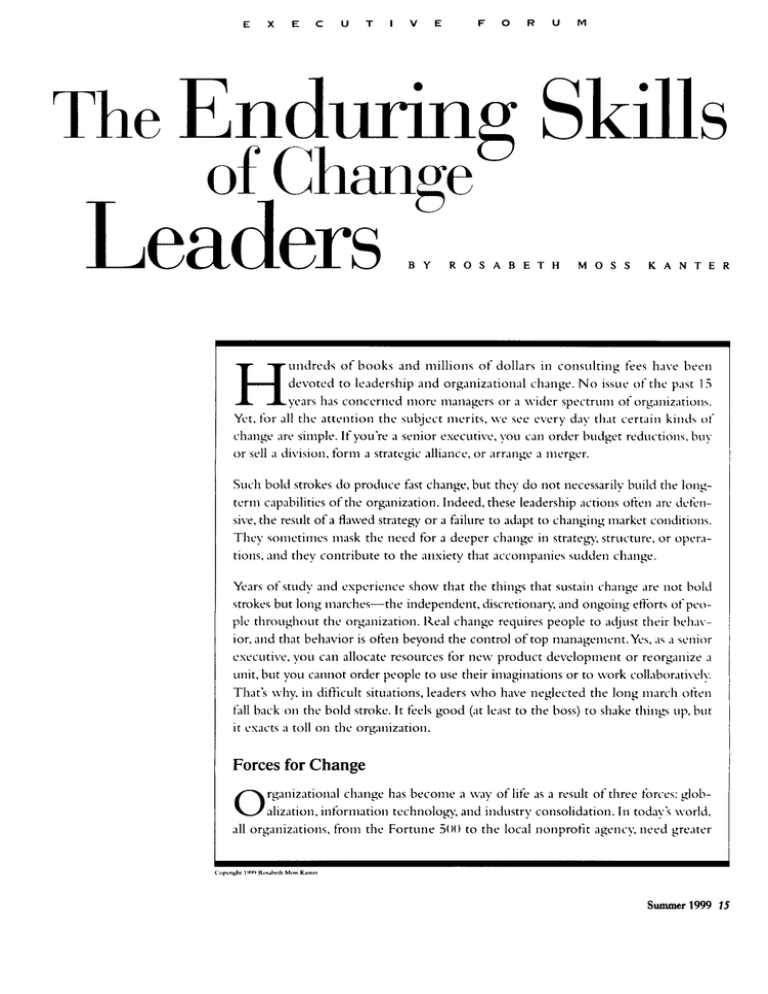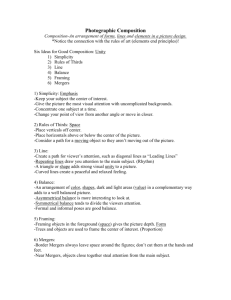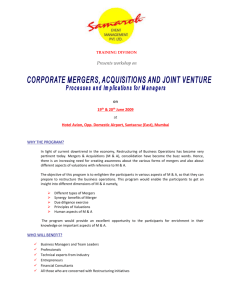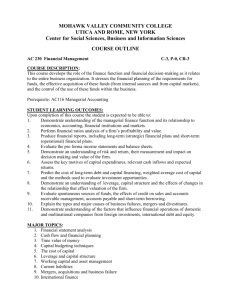Leaders Skills Enduring The
advertisement

E X E C U T I V E F O R U M The Enduring Skills of Chmge u Leaders B Y R O S A B E T H M O S S K A N T E R uiidreds of books a n d millions of dollars i n consulting fees have been devoted to 1e.iciership a n d organizational change. N o issue of the pdst 15 scars has concerned iiiorc managers o r a \\icier spectrum of organiz;rtioiis. Yet, for all t h e attention the subjcct nicrits, \ve see every day that certain kin& ot' change are simple. If you're a senior executive, you can order budget reductions. buy or sell ;I division, form a strategic alliance, o r arrange a merger. H Such bold strokes do produce fast change, but they do not necessarily build the longterm capabilities o f the organization. Indeed, these leadership actions often 'ire dcfensive, the result o f a flawed strategy o r a failure to adapt t o changing market conditions. They sonietinies mask the need for a deeper change i n strategy, structure. o r oper.1tions, iind they contribute to the aiisiety that accompanies sudden change. Years of study and cspcricnce show that the things that sustain change are not bold strokes but long marches-the independent, discretionary, and ongoing etf'orts of pcoplc throughout thc. organization. Ileal change requires people to adjust their beh,nior, and that behavior is often beyond the control of top nianagenient. Yes, '1s J scnior csecutive, you can allocate resources for n e w product development o r reorganize J unit, but you cannot order people to use their imaginations o r t o \vork collaboratively. That's \vhy, in difficult situations, leaders w h o have neglected the long march often fall back on the bold stroke. I t feels good (at least to the boss) to shake things L I ~ but , i t exacts a toll on the organization. Forces for Change rganizational change has become a \vay of life '1s a result of three forces: globalization, information tcchnoloby, and industry consolidation. I n today's \vorld. all organizations, from the Fortune 500 to t h e local nonprofit agency, need gredter 0 Summer1999 15 reach. They need to be in more places, to be more aware of regional and cultural differences, and to integrate into coherent strategies the work occurring in different markets and communities. The first two foxes for change-globalization and technology-will inevitably grow. But it’s not enough for organizations to simply “go international” or “get networked.” In a global, high-tech world, organizations need to be more fluid, inclusive, and responsive. They need to manage complex information flows, grasp new ideas quickly, and spread those ideas throughout the enterprise.What counts is not whether everybody uses e-mail but whether people quickly absorb the impact of information and respond to opportunity. Industry consolidation, the business story of 1998-99, has a less certain hture.But even if that trend abates, the impact of mergers, acquisitions,and strategic alliances will be felt for years. Mergers and acquisitions bring both dangers and benefits to organizations (see “Innovating in the Age of Megamergers,” page 19).Partnerships,joint ventum, and strategic alliances can be a less dramatic but more highly evolved vehicle for innovation. However, you must not starve an alliance or a partnership.You have to invest the time and resources to work out differences in culture, strategy, processes, or policies. You also have to bring together people at many levels to talk about shared goals and the hture of the alliance in general, not just their small hnctional tasks. Many alliances unravel because, while there is support at the top of the organization, departments at lower levels are left to resolve tensions, answer ques- 16 Leader to Leader tions, or fill gaps on their own. The conflicts and wasted efforts that result can end up destroying value instead of creating it.You have to make sure that the goals of people at many levels of the organizations are aligned, and that people get to know each other, before you can expect them to build trust. Keys to Mastering Change hange is created constantly and at many levels in an organization.There is the occasional earthshaking event, ofien induced by outside forces; there are also the everyday actions of people engaged in their work. In change-adept organizations,people simply respond to customers and move on to the next project or opportunity.They do not necessarily change their assumptions about how the organization operates, but they continuously learn and adapt, spread knowledge, share ideas. By making change a way of life people are, in the best sense, “just doing their jobs.’’ C Change-adept organizations share three key attributes, each associated with a pamcular role for leaders. The imagination to innovate. To encourage innovation, effective leaders help develop new concepts-the ideas, models, and applications of technology that set an organization apart. The professionalism to pe$orm. Leaders provide personal and organizational competence, supported by workforce training and development, to execute flawlessly and deliver value to ever-more-demanding customers. The openness to collaborate. Leaders make connettiom with partners who can extend the organization’s reach, enhance its offerings, or energize its practices. These intangible assets-concepts, competence, and connections-accrue naturally to successll organizations,just as they do to successfid individuals. They reflect habits, not programs--personal skills, behavior, and relationships. When they are deeply ingrained in an organization,change is so natural that resistance is usually low. But lacking these organizational assets, leaders tend to react to change defensively and ineffectively. Change compelled by crisis is usually seen as a threat, not an opportunity. plan, launch a task force, and then simply hope that people find the answers-instead of offering a dream, stretching their horizons, and encouraging people to do the same. That is why we say, “leaders go first.” However, given that passion, conviction, and confidence, leaders can use several techniques to take charge of change rather than simply react to it. In nearly 20 years of working with leaders I have found the following classic skills to be equally u s e l l to CEOs, senior executives, or middle managers who want to move an idea forward. Mastering deep change-being first with the best service, anticipatingand then meeting new customer requkments, 1. Tuning in to the environment. applying new technology-reAs a leader you can’t possibly quires organizations to do more know enough, or be in enough places, to understand everydung than adapt to changes already in progress. It requires them to be happening inside-and more fast, a d e , intuitive, and innovaimportantly outside-your orChange compelled by crisis tive. Strengthening relationships ganization. But you can actively is usuazz~ Seen as a with customers in the midst of collect information that sugnot an opportunity. gests new approaches.You can market upheaval can help ors create a network of listening ganizations avoid cataclysmic change-the kind that costsjobs posts--a satellite office, a joint and jolts communities. To do venture, a community service. that, effective leaders reconceive Rubbermaid operates its own their r o l d r n monitors of the stores, for instance, even though organization to monitors of exit sells mostly to Wal-Mart and other big chains.These stores allow the company to listernal reality They become idea scouts, attentive to early ten to and learn from customers. Likewise, partnerships signs of discontinuity,disruption, threat, or opportunity in the marketplace and the community.And they mate and alliances not only help you accomplish particular channels for senior managers,salespeople,service reps, or tasks,they also provide knowledge about things hapreceptionists to share what customers are saying about pening in the world that you wouldn’t see otherwise. products. Look not just at how the pieces of your business model fit together but at what doesn’t fit. For instance, pay speClassic Skills for Leaders cial attention to customer complaints, which are ofien your best source of information about an operational he most important things a leader can bring to a weakness or unmet need. Also search out broader signs changmg organization are passion, conviction, and of change--a competitor doing somethmg differently confidence in others. Too ofien executives announce a T Summer 19% 17 or a customer using your product or service in unexpected ways. 2. CMknging the p m i l i n g organizational wisdom. Leaders need to develop what I call kaleidoscope thinkinc a way of constructing patterns fmm the fragments of data available,and then manipulating them to form different patterns. They must question their assumptions about how pieces of the organization,the marketplace, or the community fit together. Change leaders remember that there are many solutions to a problem and that by looking through a different lens somebody is going to invent, for instance, a new way to deliver health care. you’ve got to make a compelling case. Leaders talk about communicating a vision as an instrument of change, but I prefer the notion of communicating an aspiration. It’s not just a picture of what could be; it is an appeal to our better selves, a call to become something more. It reminds us that the future does not just descend like a stage set; we construct the hture fkom our own history, desires, and decisions. 4. Building coalitions. Change leaders need the involvement of people who have the resources, the knowledge, and the political clout to make things happen. You want the opinion shapers, the experts in the field, the values leaders. That sounds obvious, but coalition building is probably the most neglected step in the change process. There are lots of ways to promote kaleidoscopic thinking. Send people outside the comm pany-not just on field trips, You cannot sell change In the early stages of planning but “far afield trips.” Go outside change, leaders must identify your industry and return with without genuine conviction. key supporters and sell their fresh ideas. Rotate job assignm dream with the same passion ments and create interdisciand deliberation as the entreplinary project teams to give people h s h ideas and opportupreneur.You may have to reach deep into, across, and outside nities to test their assumptions. For instance, one innovative the organization to find key department of a U.S. oil cominfluencers, but you first must be willing to reveal an idea or proposal before it’s ready. pany regularly invites people from many different Secrecy denies you the opportunity to get feedback, departments to attend large brainstorming sessions. and when things are sprung on people with no warnThese allow interested outsiders to ask questions, make ing, the easiest answer is always no.Coalition building suggestions, and trigger new ideas. requires an understanding of the politics of change, and in any organization those politics are formidable. 3. Communicating a compelling aspiration. You cannot sell change, or anything else, without genuine conviction, When building coalitions, however, it’s a mistake to try because there are so many sources of resistance to overcome:“We’ve never done it before.”“We tried it before to recruit everybody at once. Think of innovation as a venture. You want the minimum number of investors and it didn’t work.” “Things are O K now, so why necessary to launch a new venture, and to champion it should we change?”Especially when you are pursuing when you need help later. a true innovation as opposed to responding to a crisis, 18 Leader to Leader 5. T r a r r ~ j % r g oumrership to a workirg team. Once a coalition is in place, you can enlist others in implementation. You must remain involved-the leader’s j o b is to support the team, provide coaching and resources, and patrol the boundaries within which the team can fieely operate. But you cannot simply ask managers to execute a filly formed change agenda; you might instead develop a broad outline, informed by your environmental scan and lots of good questions, from which people can conduct a series of small experiments. That Innova& in the h e of Megamergers U Do mergers and acquisitions impair innovation? It depends on the nature of the deal and the abilities of leaders. Some consolidations, such as the effectively managed merger of Sandoz and Ciba Gigy to form Novartis, are growthoriented. In that case, most of the pieces that were combined and eventually sold off were in the chemical business. What remained was a new, strategically coherent life sciences company. It can grow by building new knowledge and collecting in one place a set of diverse products that prrviously had been scattered. The key for leaders in a growthoriented merger-where the aim is to tackle new markets and do things together that could not be done separately-is to foster communication, encourage involvement, and share more knowledge of overall strategy, special projects, and how the pieces of the new entity fit together. On the other hand, many mergers are aimed primarily at reducing capacity and cutting costs. That is the case in most of the recent banking and financial services mergers, for instance. These con- U the deal and to satisfy the demands of shareholders-can threaten the hnding of promising experiments and disrupt innovation. Massive mergers can also drive out the knowledge that fuels innovation. Massive mergers can drive out the knowledge that fuels innovation. solidations,and the efticiencies that result, can make good economic sense. Yet massive organizational change ofien drains so much time and energy that the sustainable benefits of the long march are lost, and the temptations of the bold stroke are irresistible. Often this leaves leaders with the task of putting the best face on what, for many employees, is not a promising hture. Merged organizations often lose a degree of stafFprofessionalismbecause people resent losing a voice in their destiny or having to do tasks that they’re not prepared for. Training budgets and opportunities for collegial exchange also tend to shrink. Most consolidations fail to create more integrated, value-adding enterprises and fall short of their promised benefits. That is what makes them such a demanding test of leadership. Mergers that focus on cost cutt i n e o f t e n necessary to pay for Summer1999 19 approach not only confers team ownership, but allows people to explore new possibilities in ways that don’t bet the company or your budget. It’s the hard work in between that demands the attention and effort of savvy leaders. 7. Making everyone a hero. Remembering to recognize, As psychologist Richard Hackman has found, it is not reward, and celebrate accomplishmentsis a critical lead- just the personalities or the team process that determine success; it’s whether or not the team is linked appropriately to the resources they need in the organization (see “Why Teams Don’t Work,” Winter 1998).In addition, leaders can allow teams to forge their own identity, build a sense of membership, and enjoy the protection they need to implement changes. One of the temptations leaders must resist is to simply pile responsibility on team members. While it is fashionable to have people wear many hats, people must be given the responsibilityand the time-to focus on the Resist the tasks of change. ership skill. And it is probably the most underutilized motivational tool in organizations.There is no limit to how much recognition you can provide, and it is ofien h e . Recognition brings the change cycle to its logical conclusion, but it also motivates people to attempt change again. So many people get involved in and conmbute to changing the way an organization does dungs that it’s important to share the credit. Change is an ongoing issue, and you can’t fiord to lose the talents, skills, or energies of those who can help make it happen. 6. Learning to pmevwe. My personal law of management,if not emptation to pile res; lonsibility on team members. of life, is that everything can look like a failure in the middle. One of the mistakes leaders make in change processes is to launch them and leave them. There are many ways a change initiative can get derailed (see “Sticky Moments in the Middle of Change”). But stop it too soon and by definition it will be a failure;stay with it through its initial hurdles and good things may happen. Ofcourse, ifa change process takes long enough you have to return to the beginning-monitor the environment again, recheck your assumptions, reconsider whether the proposed change is still the right one. Abdicating your role undermines the effort because, unlike bold strokes, long marches need ongoing leadership. Most people get excited about things in the beginning, and everybody loves endings, especially happy endings. 20 Leader to Leader oday’s organizations have come to expect bold strokes from their leaders. Sometimes these are appropriate and effectivwhen a project or p d uct that no longer works is put to rest. But bold strokes can also disrupt and distract organizations. They often happen too quickly to facilitate real learning, and they can impede the instructive long marches that ultimately carry an organization forward. That is why imagination, professionalism,and openness are essential to leadership,not just to leading change. They give organizationsthe tools to absorb and apply the lessons of the moment. T Likewise, techniques that facilitate change within organizations-creating listening posts, opening lines of communication, articulating a set of explicit, shared goals, building coalitions, acknowledging others-are key to creating effective partnerships and sustaining Sticky Moments in the Middle of Change- mdHow to Get Unstuck mance accodmg to strictly planned delivery. Every idea, especially if it is new or different, runs into trouble before it reaches fruition. However, it’s important for change leaders to help teams overcome four predictable-but potentially fatalroadblocks to change. Roads curve. Everyone knows that a new path is unlikely to run straight and true, but when we actually encounter those twists and turns we often panic. Especially when attempting to make changes in a system, diversions are likely, and unwelcome. Forecasts fall short. You have to have a plan-but if you are doing something new and different, you should not expect it to hold. Plans are based on experience and assumptions. When attempting to It’s a mistake to simply stop in your tracks. Every change brings You have to have a plan for changebut you should not expect it to hold. 8 innovate, it is difficult to predict how long something will take or how much it will cost (you can predict, however, that it will probably take longer and cost more than you think). Change leaders must be prepared to accept serious departures fiom plans. They must also understand that if they hope to encourage innovation it is foolish to measure people’s perfor- unanticipated consequences, and teams must be prepared to respond, to troubleshoot, to make adjustments, and to make their case. Scenario planning can help; the real message is to expect the unexpected. Momentum slows. After the excitement and anticipation of a project launch, reality sinks in.You do not have solutions to the problems you face; the multiple demands of your job are piling up; the people you have asked for information o r assistance are not returning your calls. The team is discouraged and enmeshed in conflict. I t is important to revisit the team’s mission, to recognize what’s been accomplished and what remains, and to remember that the Werences in outlook, background, and perspective that now may divide you will ultimately provide solutions. Critics emerge. Even if you have built a coalition and involved key stakeholders, the critics, skeptics, and cynics will challenge youand they will be strongest not at the beginning but in the middle of your efforts. It is only then that the possible impact of the change becomes clear, and those who feel threatened can formulate their objections. This is when change leaders-often with the help of coalition members, outside partners, or acknowledged expertscan respond to criticism, remove obstacles,and push forward. Tangible pmgress will produce more believers than doubters. Summer 1909 21 high performance, not just to managing change. They build the trust and commitment necessary to succeed in good times or in bad. Even periods of relative sta- random and chaotic. And they inspire voluntary behavior-the degree of eEort,innovation, and entrepreneurship with which employees serve customers and seek theme of leadership literature most critical to success.People’s Assets that cannot be reason. Leaders set for a good ideas or concepts, their committhe direction, define the conmerit to hish stan* ofcorncontrolled by* rule are most text, and help produce coherpetence, and their connections critical to success. ence for their organizations. of trust with partners are what m Leaders manage the culture, or set apart great organizations.All at least the vehicles through these requirements can be enwhich that culture is expressed. hanced by leaders, but none can They set the boundaries for colbe mandated. For all the upb r a t i o n , autonomy, and the sharmg of knowledge and heaval of the past 15 years, that may be the biggest ideas, and give meaning to events that otherwise appear change of all. rn 22 Leader to Leader





